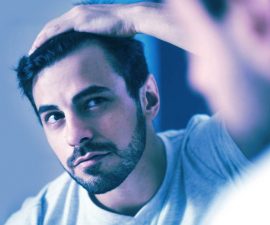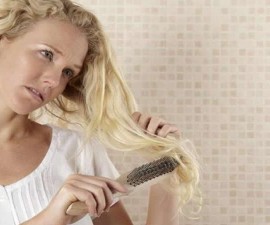… Continued …
Treatments for traumatic alopecia (hair breakage)
The following tips can help:
Recognize the problem early and take action immediately!
You may not know that your hair is breaking. Sometimes it doesn’t have any symptom until it has become advanced. Even if you have noticed a symptom, you may also admit that your hair is breaking.
When the problem is caught early, it is relatively easier to treat. You may not be able to clearly observe the problem. If necessary, ask your friend or family member to see directly at your hair.
Don’t take relaxer ‘too often’!
One of common causes is the use of relaxer. If you take it, how often you get a touch up?
Getting relaxer every 6-8 weeks is common. But if you do it once a month or too often, this may cause damage to your hair shaft. If you think that it is too much, reduce it or avoid it if necessary!
Pay attention on the winter, when the humidity is low and your hair is easier to revert. In this season, it’s better to take relaxer every 8-10 weeks or longer if necessary!
Avoid using two chemicals at the same time!
To achieve better appearance, you may be tempted to combine two chemical processes such as hydrogen peroxide, or hair dyes, with relaxers. The damage from this combination could be double.
Tips; it’s better to pick one or consider taking another chemical treatment! If you need to use two chemicals, don’t do this at the same time – wait a few weeks after applying one before applying the other.
Use any heated-tools wisely!
Pay attention on the use of any hairstyle tools that can worsen the damage such as hair dryers and flat iron tool (curling). If you need to use them, set the heat level as low as possible!
What else?
- Brushing your hair when you only need to style it! Excessive brushing and combing can contribute to result in breakage, especially for black women who usually have vulnerable hair breakage.
- Avoid the use of rubber bands or other things that can physically break the hair shaft.
- Natural hairstyle is one of popular hairstyles in black women. But remember that it is not the immune to the possibility of traumatic alopecia. For instance, if your locks /twists are twisted too tight, this can contribute to cause hair breakage, too!
- It’s also important to understand that just because there is no any symptom of hair loss after taking the risky hairstyles (such as with flat ironing, blow drying, or relaxers), this doesn’t mean that your hair is strong enough to take these hair practices all the time. Eventually, these may result in hair breakage at another time.
- If you notice that you hair starts to break, find help promptly! Trim it, wash & condition it every two week. Ask your stylist for more advice.
How about CCCA (central centrifugal cicatricial alopecia)?
Unfortunately, many women are likely to camouflage the affected area instead of seeing a doctor /dermatologist. Even some choose the wrong ways that can worsen the problem such as tight braids or glued-in waves to hide or ignore the problem.
The bad news, hair follicles are difficult to grow or even they may never grow back again in areas where the follicles have been replaced by fibrosis (scaring). The exact cause of CCCA is also unclear yet, this can be another issue of why it is difficult to treat (targeted therapy for the problem is not available).
So far, the treatment options include:
- The prescription of some anti-inflammatory medicines such as hydroxychloroquine, calcineurin inhibitors, or potent topical steroids.
- Hair transplant surgery, especially if you have a well controlled CCCA.
- Your dermatologist may also suggest a steroid injection or topical steroid to help ease the symptoms such as itching, tenderness, and soreness.
- For viable follicles, the use of minoxidil may help.
- Safe hairstyle practices are important for any women, especially for those with CCCA.
Traction alopecia
The key point to treat traction alopecia is discontinuation of any hairstyle practices that can excessively pull your hair follicles.
So, the discontinuation of the traction causing hairstyle is the mainstay of the treatment.
What are kinds of hairstyles you need to avoid? Typically, the traction producing hairstyle is painful or uncomfortable (see the previous page). Even you may find difficulty to move your temples or forehead for several days. As a result, you will experience some of the following symptoms:
- Early stage of traction alopecia is usually followed with red bumps or flaking of the scalp.
- Short broken hairs.
- If you continue with your traction causing hairstyle, your hair loss may become permanent (this may be the worst scenario).
If necessary, your doctor may prescribe topical steroid creams or steroid injection to improve the inflammation quickly. The good news, many times traction alopecia is temporary. Your hair loss will most likely to regrow!
Androgenetic alopecia
The treatments are available, but typically there is no cure for androgenetic alopecia. The main goal is to help slow or stop the progression of hair loss – it is usually not aimed to promote hair re-growth!
The treatments include the use of minoxidil or hormonal treatment (to control the effect of androgen).
How about hair transplant surgery? Unfortunately, there are only a few women with androgenetic alopecia who still have a stable donor site for hair transplantation.
In addition, your hair loss may also be triggered by a specific event such as stress or poor diet. This kind of hair loss is usually referred to a condition called telogen effluvium, a temporary hair loss condtion. For comprehensive guide of lifestyle measures (especially about dietary approaches) to help treat hair loss, see also this section!
- http://www.webmd.com/beauty/hair-styling/20120321/african-american-women-have-specific-hair-issues
- http://www.huffingtonpost.com/dr-susan-taylor/black-women-hair-loss_b_1457285.html (and the series)!




